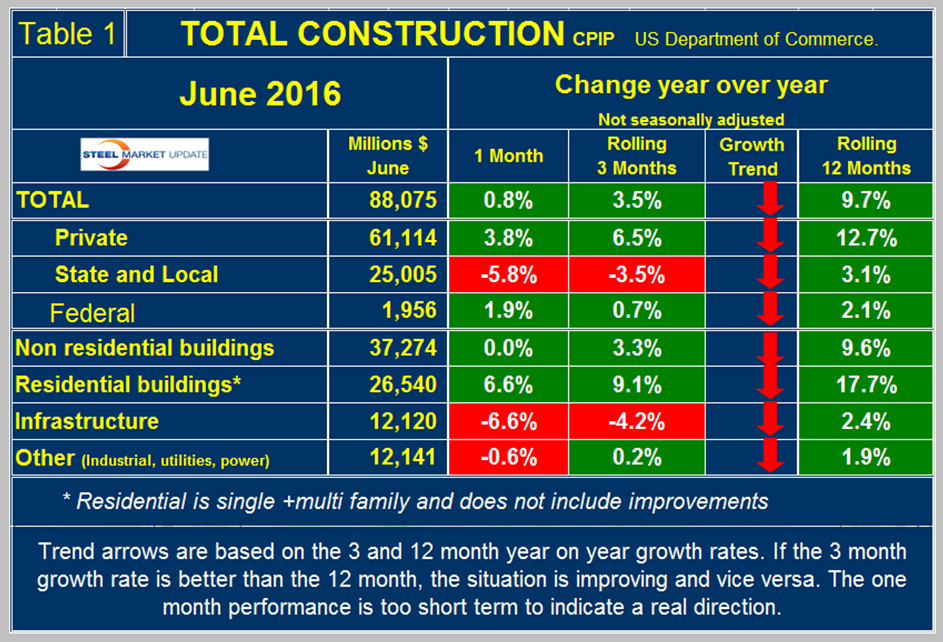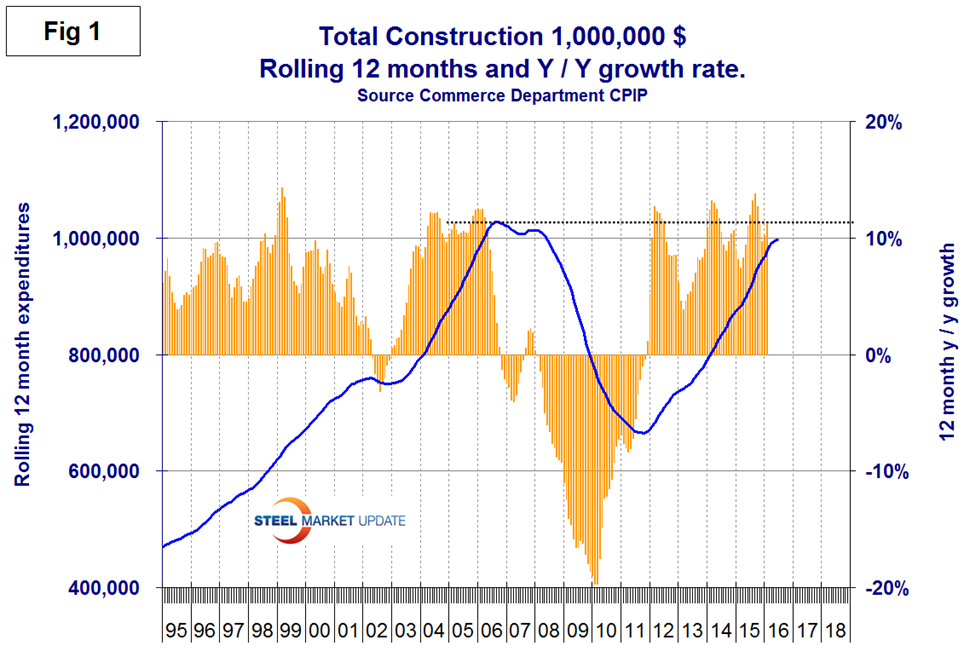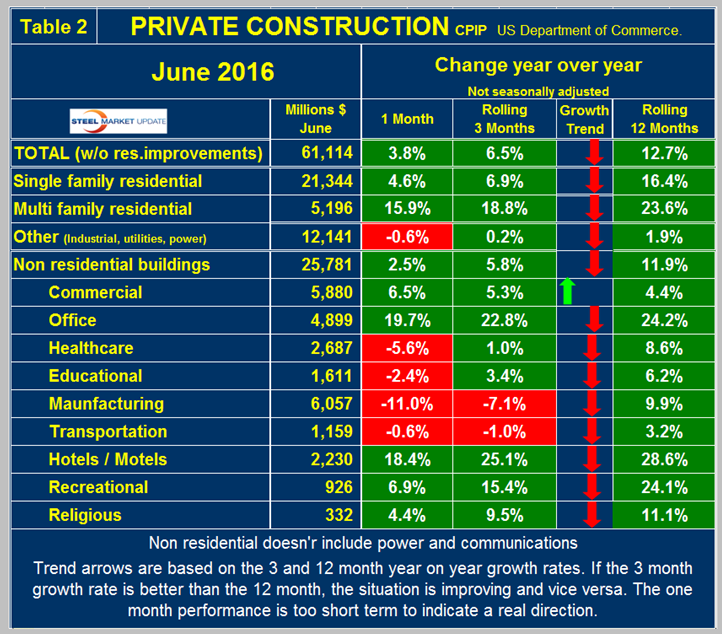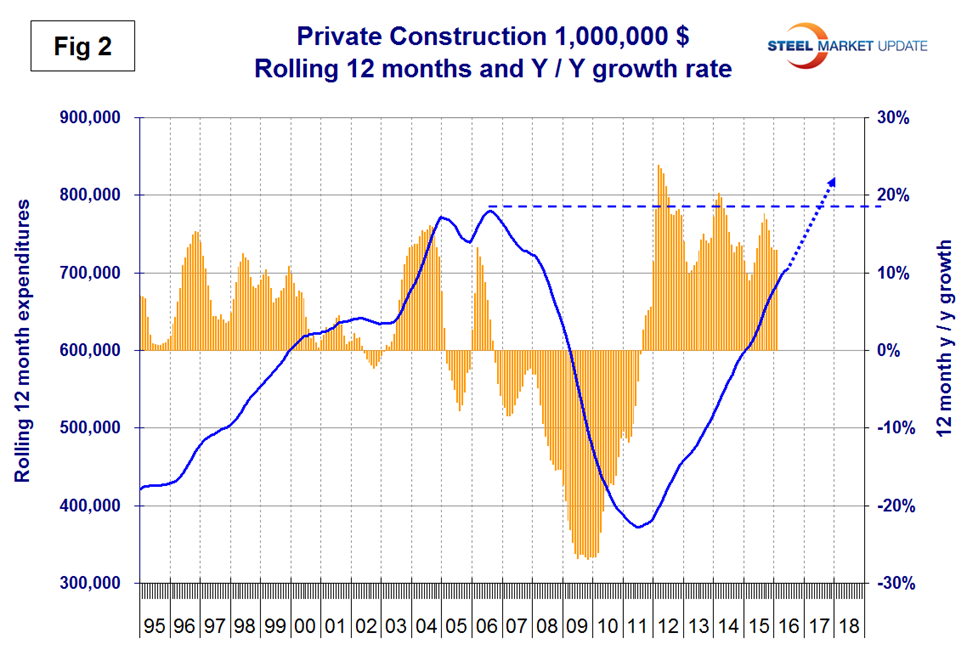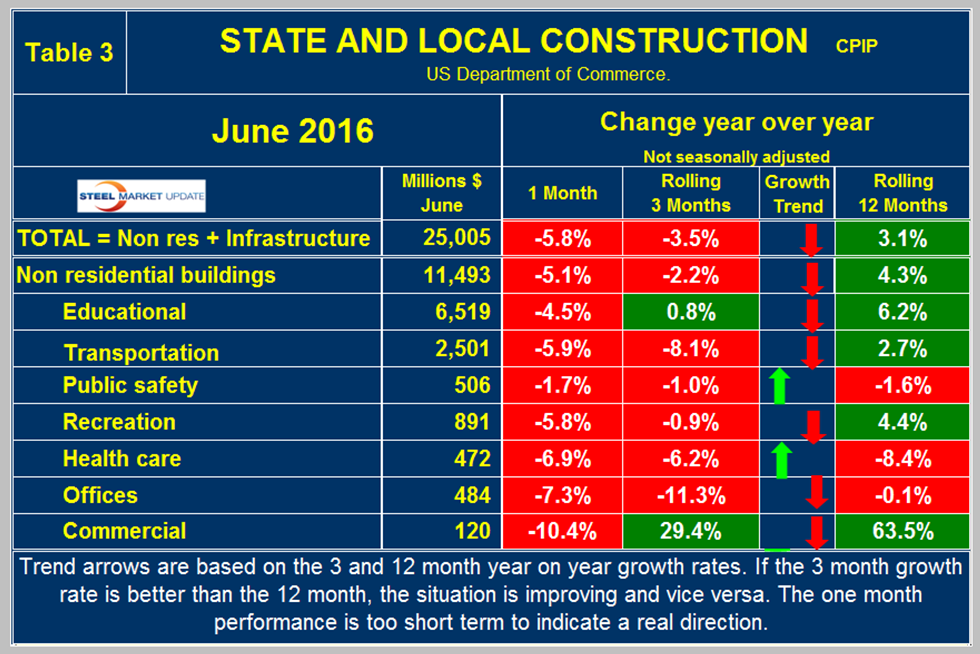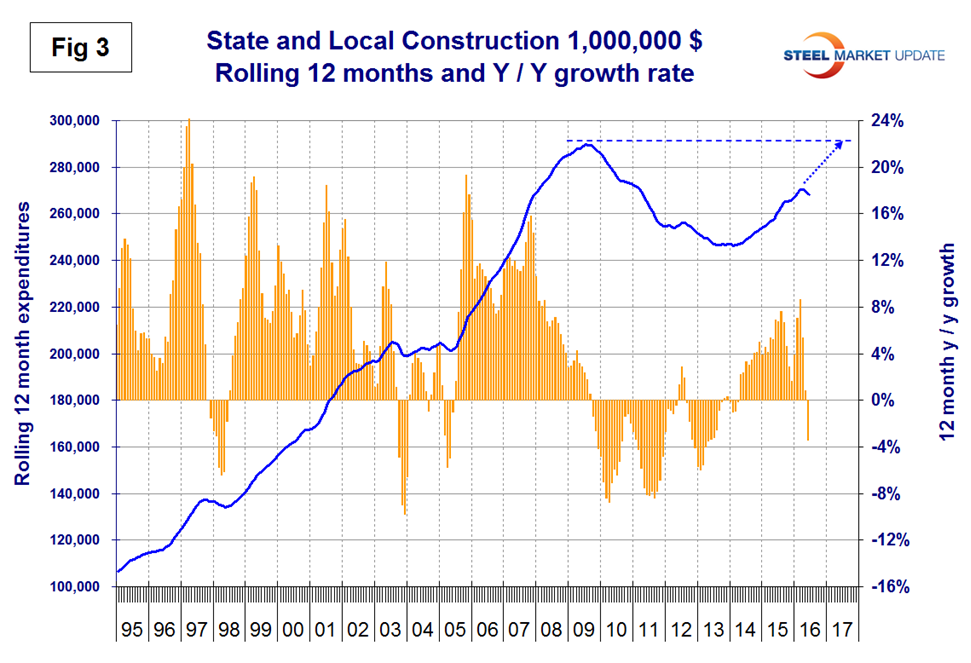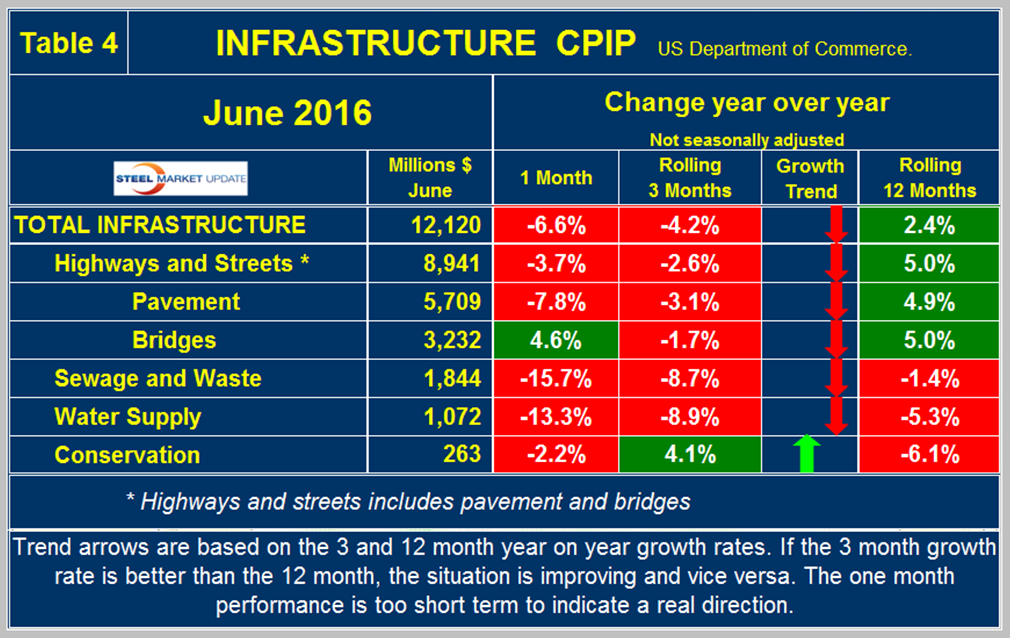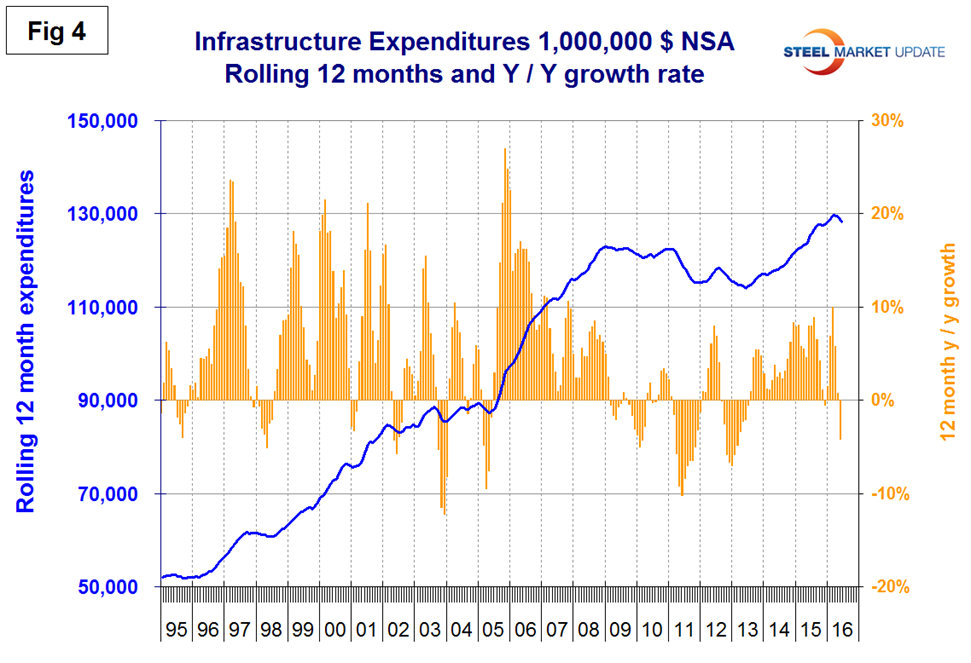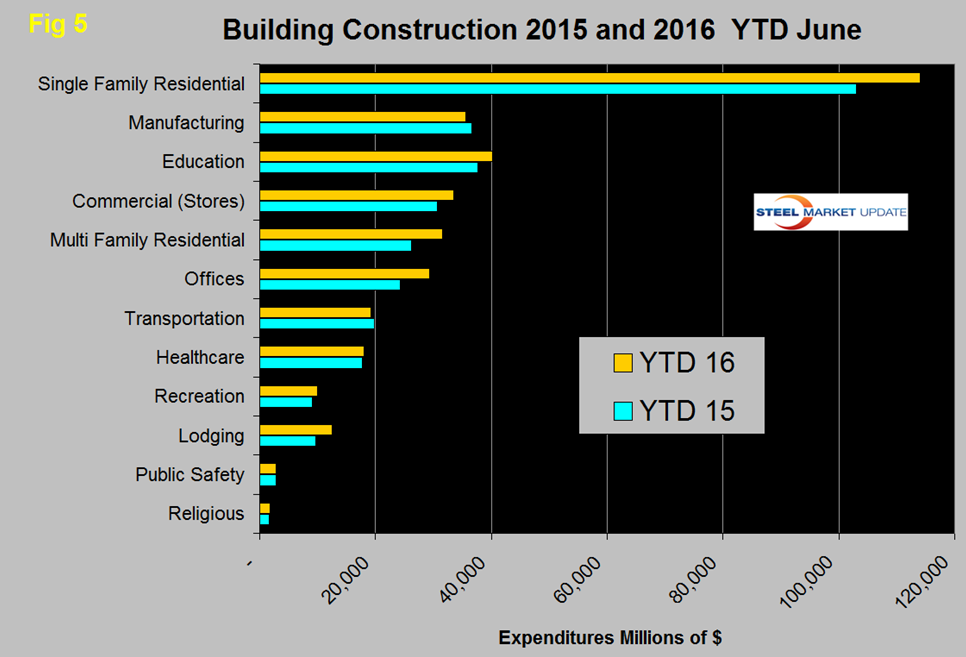Analysis

August 4, 2016
Construction Expenditures through June 2016
Written by Peter Wright
June data for Construction Put in Place (CPIP) was released by the Department of Commerce on Monday August 1st. In June total construction slowed for the third consecutive month on a 3MMA (three month moving average) basis. All four sectors had negative momentum. These are non-residential buildings, residential buildings, infra-structure and other, which is a catch all for industrial, utilities and power.
![]() At SMU we analyze the CPIP data with the intent of providing a clear description of activity that we believe accounts for over 30 percent of total steel consumption. Please see the end of this report for more detail on how we perform this analysis and structure the data but in particular note that we are presenting NONE seasonally adjusted numbers. Much of what you will see in the press may differ from what we are presenting here because others are basing their comments on adjusted values. Our rational is that construction is highly seasonal and our businesses function in a seasonal world. Also we don’t understand how the adjustments are made neither do we trust them.
At SMU we analyze the CPIP data with the intent of providing a clear description of activity that we believe accounts for over 30 percent of total steel consumption. Please see the end of this report for more detail on how we perform this analysis and structure the data but in particular note that we are presenting NONE seasonally adjusted numbers. Much of what you will see in the press may differ from what we are presenting here because others are basing their comments on adjusted values. Our rational is that construction is highly seasonal and our businesses function in a seasonal world. Also we don’t understand how the adjustments are made neither do we trust them.
Total Construction
Total construction grew by 3.5 percent in three months through June year over year down from 7.3 percent in three months through May which was the first month of single digit growth after three consecutive months of double digit expansion. On a rolling 12 months basis, construction expanded y/y by >10 percent for ten consecutive months through May then expanded by 9.7 percent in June. In the last twelve months construction growth has been as strong as at any time since our data stream began over twenty years ago, however, it is evident that growth is slowing as momentum has been negative for six of the last seven months. All growth measures included below are on a 3MMA basis year over year which eliminates seasonality.
June total construction expenditures were $88.075 billion which breaks down to $61.1 B of private work, $25.0 B of state and locally (S&L) funded work and $1.96 B of federally funded (Table 1).
The red and green arrows in all four tables in this report show momentum. June on a 3MMA basis had an increase in year over year growth of 3.5 percent which was lower than the 9.7 percent growth on a rolling 12 months basis. This means that the growth rate has negative momentum but is still historically OK. Total construction will reach the pre-recession level at the end of this year if the present growth rate is maintained (Figure 1).
The 3.5 percent growth of total construction y/y was led by private work up by 6.5 percent. State and locally financed work contracted by 3.5 percent and Federal was up by 0.7 percent. Momentum was negative for all three finance channels. We consider four sectors within total construction. These are non-residential, residential, infrastructure and other which is a catch all and includes industrial, utilities and power. All four of these sectors had negative momentum in June. The growth rate of “Other” became very negative at the time of the oil price collapse but has recovered to positive growth in the last ten months. The growth rate of total construction is shown by the brown bars in Figure 1. The pre-recession peak of total construction on a rolling 12 month basis was $1,028 B in 12 months through September 2006. The low point was $665.1 B in 12 months through October 2011. The 12 month total through the latest data of June 2016 was $996.4 B. June 2015 through June 2016 were the first months to exceed $900 B since March 2009 when the recession was gaining traction.
The Associated General Contractors of America had this to say in their blog dated August 1st. Construction spending decreased in June for the third month in a row but most segments posted solid increases in the first half of 2016 compared to the same period in 2015. Association officials said spending appears to have leveled off after a strong early start to the year prompted by mild winter weather conditions in many parts of the country.
“The drop in construction spending over the past three months is probably more a reflection of the very strong gains posted early in the year than of cooling demand for construction,” said Ken Simonson, the association’s chief economist. “Nearly every major segment had first-half gains of more than five percent compared with a year ago. Contractors, surveys and the media all continue to report plenty of projects are starting or will soon.” “We continue to worry that the slowdown in hiring and spending has more to do with the fact contractors don’t have enough workers than the fact there isn’t enough work out there,” said Stephen E. Sandherr, the association’s chief executive officer.
Private Construction
Table 2 shows the breakdown of private expenditures into residential and non-residential and subsectors of both.
The growth rate of private construction was 6.5 percent in the last three months as shown by the brown bars in Figure 2.
The blue lines in all four graphs in this report are 12 month totals which smooths out seasonal variation. Excluding property improvements, our report shows that single family residential grew at 6.9 percent and multi-family residential is still surging with an 18.8 percent growth rate. The growth of single family construction expenditures reported here is almost the same as the starts data reported by the Census Bureau. (In the starts data the whole project is entered to the data base when ground is broken as described above). However multi family is very different. In this CPIP report multifamily expenditures grew by 18.8 percent but starts data from the Census Bureau contracted at 11.2 percent. It remains to be seen whether this difference portends a future slowdown in multifamily. Within private non-residential, all sectors except manufacturing and transportation had positive growth led by hotels/motels, offices and recreational buildings, however all except commercial had negative momentum. On August 1st the Federal Reserve released their Senior Loan Officer Survey in which they review changes in the terms of, and demand for, bank loans to businesses on a quarterly basis based on the responses from 73 domestic banks and 24 U.S. branches and agencies of foreign banks. The latest survey suggests that there is currently a net increase in demand for construction and land development loans but that terms are tightening.
State and Local Construction
S&L work contracted by 3.5 percent in the rolling three months through June y/y with negative momentum (Table 3).
This was the first month of contraction since April 2014. Figure 3 shows year over year growth as the brown bars.
Educational buildings are by far the largest sub sector of S&L non-residential at $6.5 billion in June and on a 3MMA basis y/y had positive growth of 0.8 percent, down from 7.4 percent in May. The only other sector within S&L to have positive growth was commercial and this is a very small volume. (The vast majority of commercial expenditures are privately financed.) Public safety (which includes jails, police, courthouses and fire stations), and health care both had positive momentum as their contraction slowed. Recreational buildings which includes convention centers, sports arenas, theaters and miscellaneous amusements had negative growth for the first time since March 2014. Comparing Figures 2 and 3 it can be seen that S&L construction did not have as severe a decline as private work during the recession and that private work bounced back faster. Private expenditures are on track to exceed the pre-recession high by mid next year but the slowdown in S&L is making such a prediction unwise.
Drilling down into the private and S&L sectors as presented in Tables 2 and 3 shows which project types should be targeted for steel sales and which should be avoided. There are also regional differences to be considered for which data is not available from the Commerce Department.
Infrastructure
Expenditures contracted by 4.2 percent in June, this was only the second month of negative growth since July 2013. Growth has slowed from a nine year high of 10.0 percent in March this year. Highway and streets including pavement and bridges account for about 2/3 of total infrastructure expenditures and had positive growth every month since July 2013 before contracting by 2.6 percent in June this year. Highway pavement is the main subcomponent of highways and streets and had a 3.1 percent negative growth in three months through June. Bridge work contracted by 1.7 percent after having positive growth for each of the 12 months through April and contracting by 3.2 percent in May (Table 4).
Infrastructure expenditures were slow to respond to the recession due to the magnitude of many of these projects. Growth stopped in 2009 and 2010 but it wasn’t until 2011 that an actual contraction occurred. For most of 2015 through June 2016 infrastructure expenditures exceeded the pre-recession high (Figure 4).
It looks as though the passage in late December of the congressional bill for $305 billion to fund roads, bridges, and rail lines June has not have kicked in yet due the long planning and permitting processes for such projects. The five-year infrastructure bill is the longest reauthorization of federal transportation programs that Congress has approved in more than a decade, ending an era of stopgap bills and half-measures that left the Highway Trust Fund nearly broke and frustrated local governments and business groups.
Total Building Construction Including Residential
Figure 5 compares YTD expenditures for building construction for 2015 and 2016.
Single family residential is dominant and in the first six months of 2016 totaled $114 billion, up from $103 billion in the same period last year. Manufacturing, transportation and public safety have contracted in the first half of 2016 compared to the same period last year. All other sectors are doing better led by lodging (hotels and motels) were up by 28.1 percent followed by offices up by 21.1 percent and multi-family residential buildings up 20.0 percent.
Explanation: Each month the Commerce Department issues its construction put in place (CPIP) data, usually on the first working day covering activity two months earlier. Construction put in place is based on spending work as it occurs, estimated for a given month from a sample of projects. In effect the value of a project is spread out from the project’s start to its completion. This is different from the starts data published by the Census Bureau for residential construction, by Dodge Data & Analytics and Reed Construction for non-residential and Industrial Information Resources for industrial construction. In the case of starts data the whole project is entered to the data base when ground is broken. The result is that the starts data can be very spiky which is not the case with CPIP.
The official CPIP press release gives no appreciation of trends on a historical basis and merely compares the current month with the previous one on a seasonally adjusted basis. The data is provided as both seasonally adjusted and non-adjusted. The detail is hidden in the published tables which we at SMU track and dissect to provide a long term perspective. Our intent is to provide a rout map for those subscribers who are dependent on this industry to “Follow the money.” This is a very broad and complex subject therefore to make this monthly write up more comprehensible we are keeping the information format as consistent as possible. In our opinion the absolute value of the dollar expenditures presented are of little interest. What we are after is the magnitude of growth or contraction of the various sectors. In the SMU analysis we consider only the non-seasonally adjusted data. We eliminate seasonal effects by comparing rolling three month expenditures year over year. CPIP data also includes the category of residential improvements which we have removed from our analysis in the rational that such expenditures are minor consumers of steel.
In the four tables included in this analysis we present the non-seasonally adjusted expenditures for the most recent month of data. Growth rates presented are all year over year and are the rate for the single months result, the rolling 3 months and the rolling 12 months. We ignore the single month year/year result in our write ups because these numbers can contain too much noise. The arrows indicate momentum. If the rolling 3 month growth rate is stronger than the rolling 12 months we define this as positive momentum and vice versa. In the text, when we refer to growth rate we are describing the rolling 3 months year over year rate. In Figures 1 through 4, the blue lines represent the rolling 12 month expenditures and the brown bars represent the rolling 3 month year over year growth rates.



